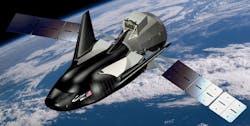SNC optimizes Dream Chaser spacecraft composite structure size, weight with HyperSizer software
NEWPORT NEWS, Va. Sierra Nevada Corp. (SNC) engineers in the Dream Chaser spacecraft team in Sparks, Nev., armed with the go-ahead from NASA for a first mission to the International Space Station (ISS), are now reviewing flight performance data and refining the space vehicle’s design adaptations to meet mission requirements and changing payloads, using HyperSizer software from Collier Research Corp. in Newport News, Virginia.
The HyperSizer tool provides critical insights into the strength, weight, and manufacturability of designs for both composite and metal structures and, officials say, can typically reduce the weight of existing designs by 20 to 40 percent. The software plays an important role in margin-of-safety certification for aerospace projects and is valuable for wind, marine, and other fields that demand performance with durability.
Dream Chaser Commercial Resupply Service 2 (CRS-2), the current model of the autonomous, reusable spacecraft, will transport pressurized and unpressurized cargo to and from the ISS, with a launch window of late 2020. The vehicle also has the potential for satellite servicing, orbital-debris removal, and exploration technology testing.
The demands of low-orbit flight, earth reentry, runway landing, and vehicle reuse require precision design optimization for reliability, durability, and safety. Each type of mission requires additional analysis due to new flight trajectories and corresponding changes to the vehicle loads.
The unique challenges faced by the structural engineers at SNC were to design the Dream Chaser to accommodate changing cargo weights and different reentry trajectories, carry pressurized and non-pressurized items, and withstand significant deflection forces.
HyperSizer was used by the team on nearly all primary composite structures for the launch-approved CRS-2 to meet these challenges, SNC engineers Andy Kim and Eric Schleicher say.
“HyperSizer’s suite of industry-standard failure criteria was extremely valuable for our team, enabling us to quickly size the Dream Chaser structure and perform architectural trade studies,” says, SNC Senior Structural Engineer Andy Kim. “The software’s rapid analysis capability gave us more time to interrogate our results and gain insights into the sensitivity of the structural weight to various design features and stiffener cross sections.”
“HyperSizer helped us improve and automate the design-analysis process for the CRS-2,” SNC Principal Structural Engineer Eric Schleicher says. “We found some of the most useful aspects of the software to be load processing, sizing, margin reporting and the finite-element model [FEM] update feature.”
“The SNC team did a great job of incorporating HyperSizer into their design and analysis process in order the hit weight and schedule targets,” adds James Ainsworth, lead stress engineer for Collier Research Corp. “They took full advantage of the software’s scripting API to customize the workflow and automate data exchange with their suite of CAE software tools. This enabled the team to move rapidly from whole-scale optimization to detailed analysis and stress reporting. It will be exciting to watch the spacecraft meet its next milestones and prepare for powered orbital space flight.”
Collier Research Corp. provides software solutions, methods research, and consulting services for the aerospace, wind energy, automotive, and recreational equipment industries with its broad range of structural capabilities.


